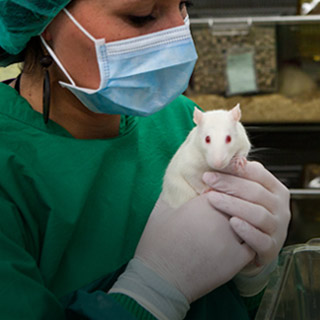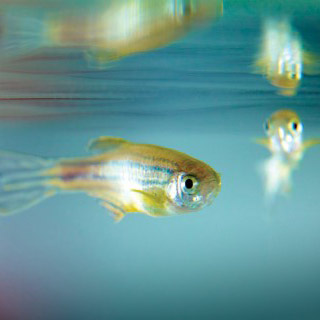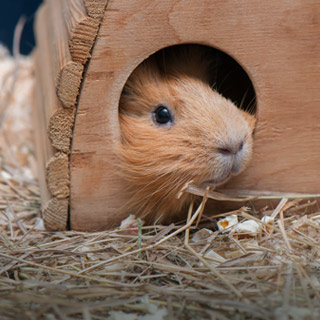AWI works to foster the development and implementation of science-based housing and handling refinements that reduce pain and distress and provide opportunities for species-appropriate mental and physical stimulation and social interaction. We promote practices that replace animals with non-animal alternatives and minimize the number of animals used in research. We also endeavor to identify and address reports of animal abuse in laboratory settings and the supply chain.
Animals in laboratories are generally used for three distinct scientific purposes: research, testing, and teaching:
- Research refers to studies meant to advance scientific knowledge by learning something new;
- Testing refers to toxicity testing of chemicals (e.g., in pesticides, drinking water, or cookware) or safety testing of products (e.g., cosmetics, household cleaning products, or drugs and vaccines);
- Teaching refers to the use of animals in an educational context, such as dissection or surgical training.
The vast majority of animals are used for research purposes, whereas a much smaller percentage are used in testing. It is common for people to use the shorthand “animal research” or “animal testing” to refer to both research and testing.
According to US Department of Agriculture reports, each year some 800,000 warm-blooded animals are used in research, testing, and teaching in the United States, with another 150,000+ held in registered research facilities but not used for regulated activities. These numbers do not include the following animals bred for use in research: rats of the genus Rattus, mice of the genus Mus, and birds, as these species have been expressly excluded from Animal Welfare Act (AWA) protections. Similarly, cold-blooded animals—also unprotected under the law—are left uncounted. This latter group comprises fish, reptiles, amphibians, and invertebrates (including cephalopods such as octopus). In fact, animals who are not covered by the AWA make up the vast majority of animals used in research, testing, and teaching: Estimates of the number of rats and mice used annually in the United States vary between 10 million and 111.5 million. In other countries, such as Canada and European Union member nations, these species are afforded greater protections, and their numbers are reported. Reports from those countries indicate that rats, mice, birds, and fish account for 80–92% of the total number of animals used (with cold-blooded vertebrates other than fish adding a negligible amount to this total). A similar percentage of these species is likely in use in the United States.
AWI’s advocacy was a vital factor in achieving passage of the AWA in 1966, as well passage of the subsequent amendments to strengthen and broaden the law. AWI now campaigns for stricter enforcement of the AWA and advocates extension of its coverage (at a bare minimum) to rats, mice, and birds. Regardless, AWI strongly believes that all animals used in research—whether or not they are afforded protections under the AWA—deserve to be treated with care and compassion.
As described in detail in our Position Statement, AWI believes that research and testing must not be conducted on animals unless, at minimum, the research plan adheres to the “3Rs” (replacement, reduction, refinement), principles introduced by William Russell and Rex Burch in 1959. According to these principles, if an equally effective and legally acceptable nonanimal alternative is available, it must be used in preference to an experiment or test conducted with an animal (replacement); experiments must be appropriately designed to generate robust, reliable, and reproducible results in order to reduce the total number of animals used for research (reduction); and, after efforts have been made to replace or reduce animal use, institutions must refine research methodology and husbandry practices to minimize animal pain and distress (refinement). Animals who are used must be maintained in an optimum, species-appropriate environment; they must be under the care of professionally trained, compassionate personnel; and their pain, discomfort, fear, and distress must be prevented or at least minimized by considerate and scientifically sound experimental design and appropriate use of anesthetic, analgesic, and tranquilizing drugs.
To help improve the lives of animals in research, AWI has created many resources geared toward individuals who work with animals in laboratories. AWI’s long-running online Laboratory Animal Refinement & Enrichment Forum (LAREF) facilitates meaningful discussion and exchange of ideas among members of the research animal care community concerning ways to improve the conditions under which animals in laboratories are housed and handled. AWI also provides funding to laboratory personnel to conduct research focused on improving the housing and handling of animals in research (via the Refinement Research Award) and to implement better practices (via the Implementing Refinement Grant). AWI distributes its publications and resources at no cost to laboratory personnel and curates a Refinement Database of scientific articles and books on topics related to improving or safeguarding the welfare of animals in research. AWI also engages in projects to expand scientific understanding of the welfare needs of animals in research and campaigns to help shape laws and policies to improve the lives of animals in research.





